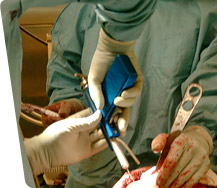The RSA® Method
RadioStereometric Analysis (RSA®) enables accurate 3D measurements from radiographs. The 3D kinematics of skeletal or implant movements can be determined between repeated examinations. RSA® has a wide range of applications – orthopedics, pediatrics, oral surgery, plastic surgery, oncology, rheumatology, neurosurgery, and hand surgery.
1. Marker Insertion
Spherical, tantalum markers (0.5, 0.8, 1.0 mm) are inserted to mark points on the skeleton. The material is biocompatible, well tolerated by the body, and readily observed as a distinct point in the radiograph. In surgery, the RSA® Injector™ is used to insert Tantalum Markers into the most appropriate anatomic structure, usually the skeleton.
Marking of prostheses is preferably done by the manufacturer as part of the manufacturing process.
2. Radiographic Examination
Two x-ray tubes (fixed or mobile) are used for simultaneous exposure of the patient and the RSA® calibration cage™. The calibration cage enables calculation of the 3D positions of the Tantalum Markers.
3. Measurement
The RSA® Digital Measure™ automatically identifies markers and calculates the 3D positions with high precision. Advanced mathematical algorithms enable high-precision, 2D positioning of the marker center, even in cases with low contrast and/or interference from nearby metal objects. Attaching Tantalum Markers to prostheses may be difficult at times. To overcome this, we have developed a method for measurement of non-marked implants.
4. Analysis
Using 3D positions from different examinations, the 3D motions of segments, skeleton, or prostheses can be calculated and presented.
5. Results
This high-precision RSA® method facilitates early conclusions, even in small studies with short-term follow-up and a small sample of patients, thereby enhancing the cost-effectiveness of research and clinical investigations.
Some Applications in Orthopedics
- Prosthetic fixation
- RSA® can detect migration exceeding 0.05 to 0.2 mm in hip arthroplasties or other artificial joints.
- Growth problems
- RSA® can monitor the skeleton in detail for optimal treatment of child growth disorders.
- Joint stability
- RSA® can measure the extent and direction of instability to determine its nature. The RSA® method opens a new horizon to assess the effectiveness of different operations in stabilizing damaged joints.
- Joint kinematics
- RSA® enables detailed, 3D recording of joint movement, facilitating studies of ligament damage, or the kinematics of artificial joints.
- Fracture healing
- RSA® facilitates the study of fracture movement during the healing period, and can be used in evaluating different treatment methods.
- Prosthetic wear
- RSA® facilitates clinical investigation and analysis of prosthetic, e.g. polyethylene (PE), wear over time.
Ethical Considerations
Insertion of tantalum markers is an established and recognized method. During a 30-year period, over 10 000 patients have been studied without any complications. No adverse reactions have occurred after implantation of tantalum markers. Nevertheless, caregivers always need to consider the potential risk for tissue damage during insertion as well as potential risks associated with infection and radiation dose.
Since the tantalum markers are radio-opaque, radiographic examination requires only a low x-ray dose. For example, the combined x-ray dose from the two machines amounts to about one-fifteenth of a standard pelvic x-ray dose.




